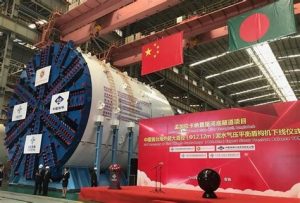Preamble: Chinese foreign policy has become more active for handling the various affairs and conditions of domestic and international level .China is giving more importance to strengthening unity and cooperation with developing countries like Bangladesh. With continuing economic growth, China is more willing to widen and expand investment, market and political clout than before. In 2013, Chinese president proposed a remarkable initiative named ‘’The Belt and Road Initiative’’ (BRI) and it is the largest step action taken by any individual nation recorded in the history. The mega project encloses Asia, Africa, and Europe in a network of roads and sea-routes. In addition, the BRI has revealed as a game changer for South Asian countries especially for Bangladesh. Bangladesh strongly support BRI as its suitable the countries priorities. The Prime Minister of Bangladesh envisioned transforming the country into middle-income by 2021 and a developed country by 2041.Bangladesh has already low-middle income status though, but it is very hard for any developing country to moving forward as there is always shortage of wealth. This paper describes the infrastructural assistance and its impact of BRI project in Bangladesh. The World Bank, recommends that countries focus on six areas of policy to improve chances of developments, among them one is ‘’improving infrastructure’’ is very important. The BRI projects are mainly related to infrastructural development and Bangladesh is one of the major beneficiaries under this initiative. BRI already present that Bangladesh needs a large amount of investment for developing infrastructure and they are offering opportunities to improve infrastructure, connectivity, trade and so on among others that’s why Bangladesh welcoming BRI. Believing that if this initiative will complete successfully it will bring huge possibility for achieving national goals and will take part to make the bridge between developing to develop.
BRI for Bangladesh’s infrastructure
- Joining BRI: The Belt and Road (BRI) is considered as a development approach and framework that emphasizes on connectivity and co-operation between china and regional countries. The Silk Road Economic Belt and the 21st Century Maritime Silk Road together known as the BRI. On 7th September 2013, President Xi Jinping first proposed the Belt and Road and its mission, vision during his visit to Kazakhstan. Bangladesh is one of the country among 136 countries from different continents and 30 international organizations who formally joined BRI.
In 2016 Bangladesh break all the rumors and joined BRI during the visit of Chinese President and the two nations signed several agreements worth $21.5 billion.
 Dhaka, Beijing sign 27 MOUs, 2016-10-14. Source: Daily Sun
Dhaka, Beijing sign 27 MOUs, 2016-10-14. Source: Daily Sun
- Infrastructure Development Partner: According to the Asian Development Bank (ADB), Asia faces an infrastructure funding gap of estimated USD 26 trillion through 2030.To address the gap, various regional and sub-regional initiatives come ahead for developing better transport connectivity. The Chinese Belt and Road Initiative (BRI) is one of the great initiative. China is a major developing partner of Bangladesh in infrastructure building bridges, roads, railways power plant etc. Bangladesh is an important member of BRI since its joining and has received significant investment from china for infrastructural development projects. Under the project Bangladesh will receive $26 billion USD for BRI and $14 billion for joint venture project and its total $40 USD billion package. And this makes Bangladesh the second largest recipient of Chinese loans under BRI in south part of Asia. Current BRI projects in Bangladesh around US$10 .Some projects are going on, some are proposed and implemented already. The Bangladesh Power System upgrade and Expansion Project, costing $165 million is a successful example of BRI and people already enjoying the facilities more than 7 million people while helping provide electricity connection to over 2.5 million rural people. China is implementing various mega infrastructure developments project such as Karnaphuli Multi-Channel Tunnel project, the Chinese Economic and Industrial Zone, the Padma Bridge rail way, Payra Power Plant, the eight China Bangladesh Friendship Bridge and the International Exhibition Centre. Few major examples are given below:
- Karnaphuli Multi-Channel Tunnel Project: In 2015,the Bangladesh Ministry of Road Transport and Bridges signed an agreement with CCCC to build the tunnel, in November 2015the ECNEC approved the project .Chinese President XI Jinping attended the inauguration of this project. The construction was started in August 2017.This is under Blithe River Tunnel in the port of Chittagong, Bangladesh is proposed 3.4 kilometer-6 kilometer long,10 meter-wide. It includes almost 6 kilometer of connecting road and the industrial area as well as the port of the city.
 Karnaphuli Multi-Tunnel.Source:Scoopnest.com
Karnaphuli Multi-Tunnel.Source:Scoopnest.com
- Overview of the project is given below:
Country————————Bangladesh.
Type of Project—————Road.
Status—————————Under Construction.
Estimated Cost—————-1.7 b billion USD$.
Initiatives———————-Belt and Road.
Date of Construction——–2017.
Completion Date————-2021.
Contractors Company——-China Communication Construction Company.
Consultants———————Arup, Cowi.
Implementers——————-Bangladesh Bridge Authority.
Supporting Bank—————-The Export-Import Bank of China.
The Tunnel will be the first tunnel in Bangladesh to facilitate simultaneous road and rail transit. And it would also attract downtown population in the east side and promote “One city and Two towns” development model adopted by Shanghai, China.
Impact of the project: The Multi-Channel Tunnel in Chittagong is expected to give a great chance for upgrading the city and the national economy of Bangladesh. The positive impacts reflects over the city’s infrastructure development and livelihood above all in Bangladesh.
- By using the ring road and tunnel people will be able to communicate from South Chittagong up to Cox’s Bazar and Teknaf bypassing Chittagong City.
- Will connect the port city of Chittagong to the far side of the Karnaphuli River the side of a new Chinese zone.
- Will reduce the travel time between Chittagong and Cox’s Bazar, one of the leading tourist spot of the country.
- Will shorten the travel time from Chittagong Airport to the Economic Zone.
- Will also feed into two other projects currently under way The Asian Highway and The Dhaka-Chittagong-Cox’s Bazar Highway.
- Will help to reduce poverty by creating employment opportunities.
It is hoped that the dream Multi-Tunnel may convert Chittagong into a Global financial Centre Shanghai bringing enormous economic benefit for Bangladesh.
- The Padma Bridge Railway: Among 20 amazing project under BRI around in various countries, it is considered that The Construction of the Core Part of The Padma River in Bangladesh is one of the biggest mega project.
 Padma Bridge Project included in China’s BRI. Photo provided by: China Daily.
Padma Bridge Project included in China’s BRI. Photo provided by: China Daily.
- Over view of the Project is given below:
Country—————– Bangladesh.
Type of Project————-Rail way.
Initiatives——————–Belt and Road.
Tenure of the Project—–January 2016-June 2022.
Estimated Cost————-Taka 34,988cr.
Funding———————-Bangladesh Government, Chinese Exim Bank.
Status————————- Under Construction.
Contractors—————–Bangladesh Railway, China Railway Construction Crop Ltd (CRCC).
Supervision Consultant–Bangladesh Army and Bureau of Research, Testing and Consultation (BRTC).
The Bridge is the Country’s largest infrastructure foreign bridge project undertaken BRI in terms of total cost.
Impact of the Project: The new Rail way Dhaka-Mawa- Janjira-Bhanga-Jashore via Padma multi -Purpose Bridge is a part of Corridor 7 as considered Railway Master Plan. On August 8, 2016, Bangladesh Railway Bureau and China Railway Group signed a deal worth $3.14 billion to set up rail link across Padma Bridge in Dhaka. The 168.6 Km railway line originating from Dhaka and terminated Jessore would also provide important rail link in south-western Bangladesh.
- Will be shortened the travel time about 3 hours instead of 13 hours between the capital, Dhaka and the 21 Southern districts of Bangladesh.
- Will connect Dhaka to Kolkata by about 5 hours.
- The Bridge will ease pressure on Chittagong sea-port as well as it will ensure development of second largest sea-port Mongla, in Bangladesh.
- Will help to make a vast scope for trading inside and outside of the country.
The project is expected to benefit Bangladesh’s economic Development increasing its GDP by an estimated 1%.
- In addition the core concept of BCIM (Bangladesh, China, India, and Myanmar) Economic Corridor Initiative is that by harnessing the comparative advantage in the four respective countries, and each of them could significantly benefit through the operationalization of crucial infrastructure connectivity and BCIM wide economic co-operation. The Corridor will be a dream transit center to connect all the member nations. China and India are the giant trade partners but the concern issue whether India will sign up for BRI. However, Bangladesh is very interested to take part in this Initiative and believe that it would be a greater chance to enhance the market access with China and India without barriers and investment in infrastructural development .The Prime Minister of Bangladesh Sheikh Hasina voiced that Bangladesh was advancing the goal of “sonar Bangla’’at present, reiterating that her country was willing to actively participate in the joint construction of Belt and Road, accelerate the building of the BCIM EC, presss ahead regional connectivity, beef up co-operation on trade, investment, service and infrastructure, so as jointly embrace an even better future.
 CIM-EC in South and Southeast Asia. Source: The Daily Star.
CIM-EC in South and Southeast Asia. Source: The Daily Star.
If the initiative come to light Bangladesh will enjoy the full advantage from this.
Impact of BCIM-EC for Bangladesh:
- Improvements of transportation infrastructure development.
- Investment in infrastructure development.
- Creation of industrial zones.
- Elimination of non-tariff barriers.
- Better trade facilitation.
- Closer people to people contact.
- Greater market to access goods.
- Better trade facility.
Overall, Bangladesh can transform itself into a part of an industrial nexus and commercial hub linking up South and Southeast Asia.
BRI boosting economic zones, support poverty reduction measures: Though China and Bangladesh’s bilateral trade reached $18.74 billion in 2018 but Bangladesh has a huge trade deficit with China. BRI has created a new door for Bangladesh to reduce the trade gap ,Bangladesh can exports to the Chinese market is now more open to lift many tariff and others obstacles.
Economists also think that BRI has given a strong and effective platform for Bangladesh for negotiating with China over more exporting in its market. Bangladesh is setting up special economic zones in several areas for rapid economic development through industry, production, employment. The BRI project can be a great opportunity to bring foreign investors for these economic zones. Bangladesh has achieved a remarkable success in poverty reduction but still 12.9% people are extreme poor so Bangladesh needs to work hard and BRI has been showing to Bangladesh to learn the lesson how to reducing poverty rapidly in a way. Currently many people working under a lots of Chinese companies in Bangladesh, is a great example for employment opportunity.
Concluding words: In 2013, The BRI has attracted attention all over the world. What the Initiative would like to achieve is more than a free trade, but less than a common market. The aim of BRI is to enjoy the outcome of economic globalization through mutual benefits, enhance mutual respect above all win win co-operation for each country. According to analysts, within next twenty years Bangladesh’s economic growth will cross most of the nations in the region. Joining BRI for Bangladesh is a huge advantage and once the project implemented Bangladesh economy will increase beyond imagination. Overall the strategic position of Bangladesh makes her, one of the significant beneficiaries of BRI.
References:
- Xinhua News Agency, 2019-07-05(China, Bangladesh Agree to Belt and Road Cooperation).
- Dahlan, M.r. (2018). Dimensions of the New Belt & Road International order: An Analysis of the Emerging Legal Norms and a Conceptionalisation of the Regulation of Disputes. Beijing Law Review, 9, 87-112.
- Xinhuanet, 2016-10-15(China, Bangladesh lift ties to strategic partnership of cooperation.
- The Daily Star, 2015-03-11 (BCIM-Economic opportunities for Bangladesh).
- Md Enamul Hasan, 2019-04-26.Chinadaily.com.cn
- Hu Biliang, 2019-10-15, (The Belt and Road Initiative fuels globalization and sustainable development).World outlook. BEIJING REVIEW.
- https://www.beltroad-initiative.com/projectoverview-Accesed on 25 October.
- https://beltandroad.hktdc.com/en/insight… – Accessed on 25 October.
Author:
Sajeda Sultana
Student, Masters of Public Administration,
Beijing Normal University, Zhuhai, China
Assistant Director, International Affairs,
China Bangladesh Friendship Center Limited-CBFCL
